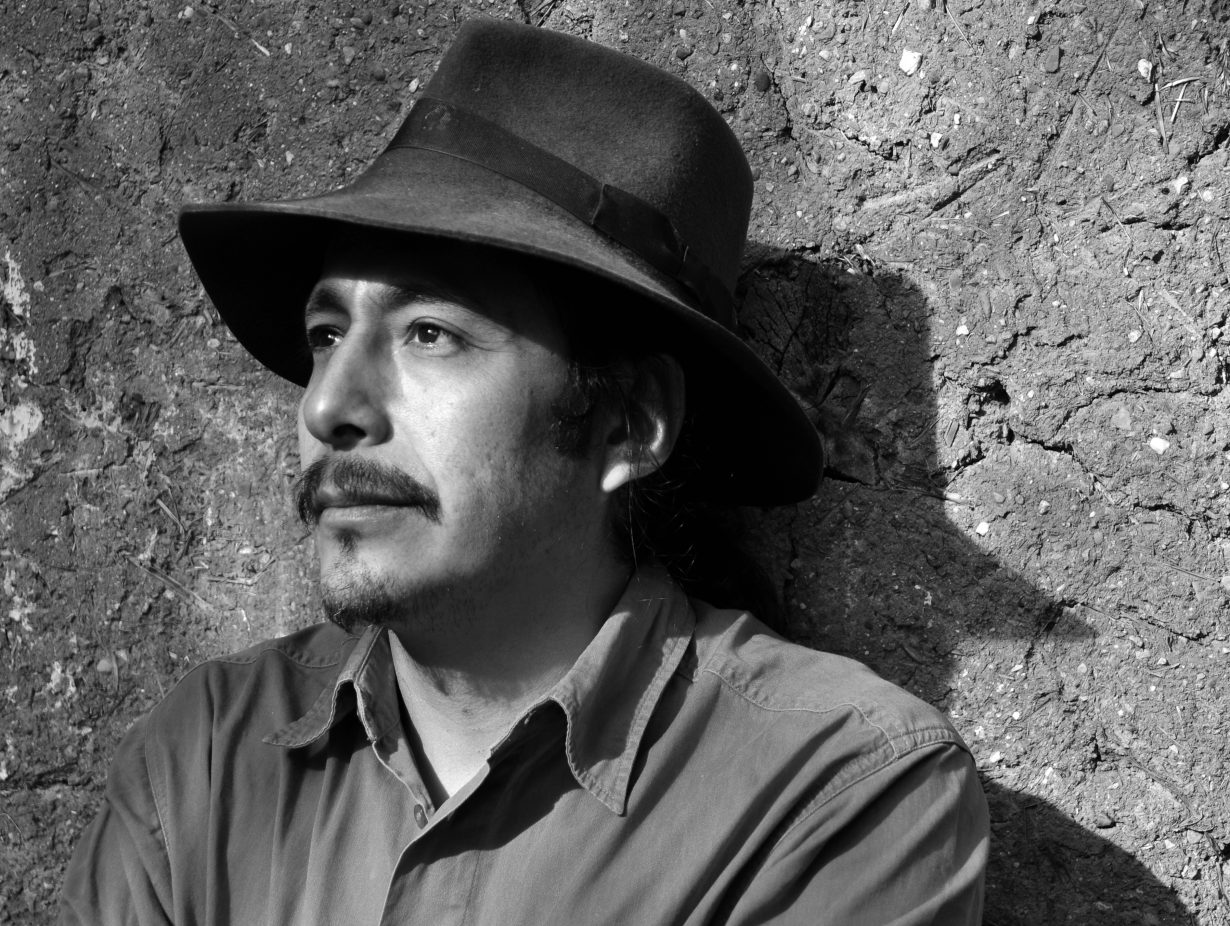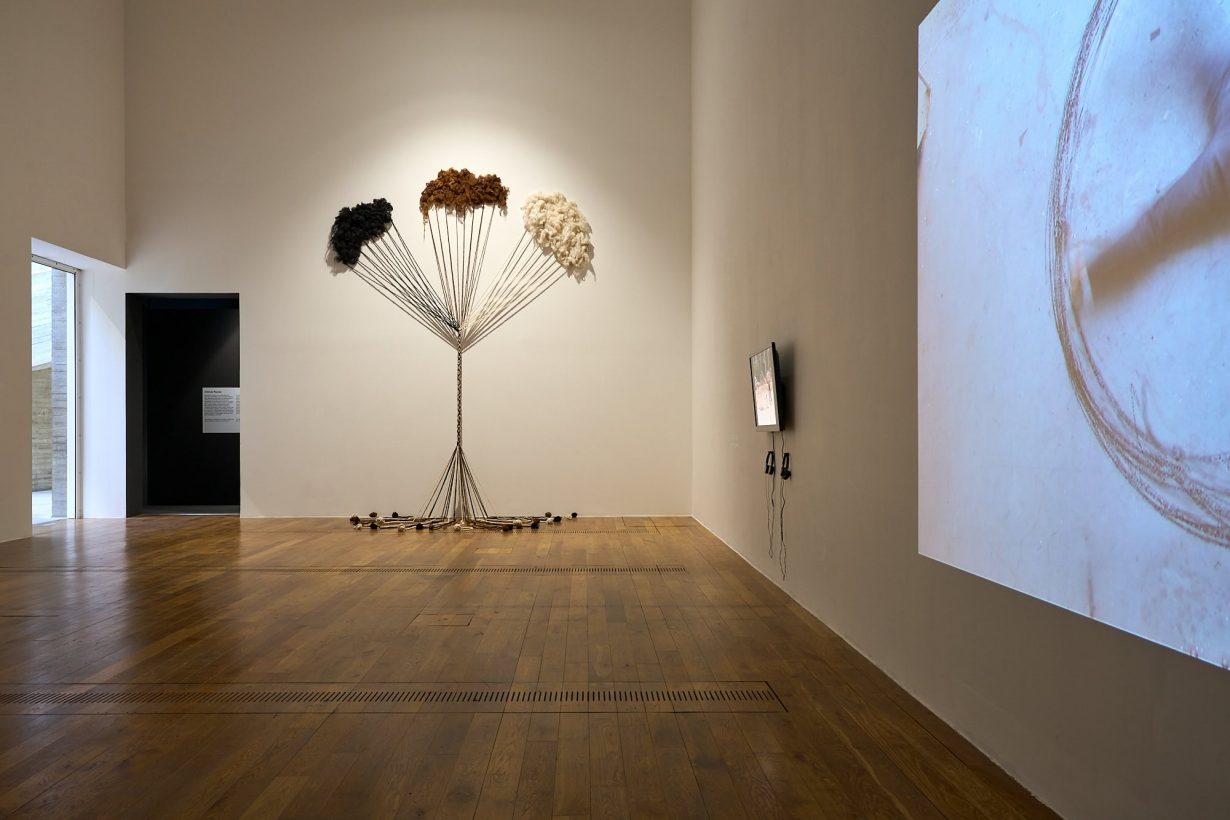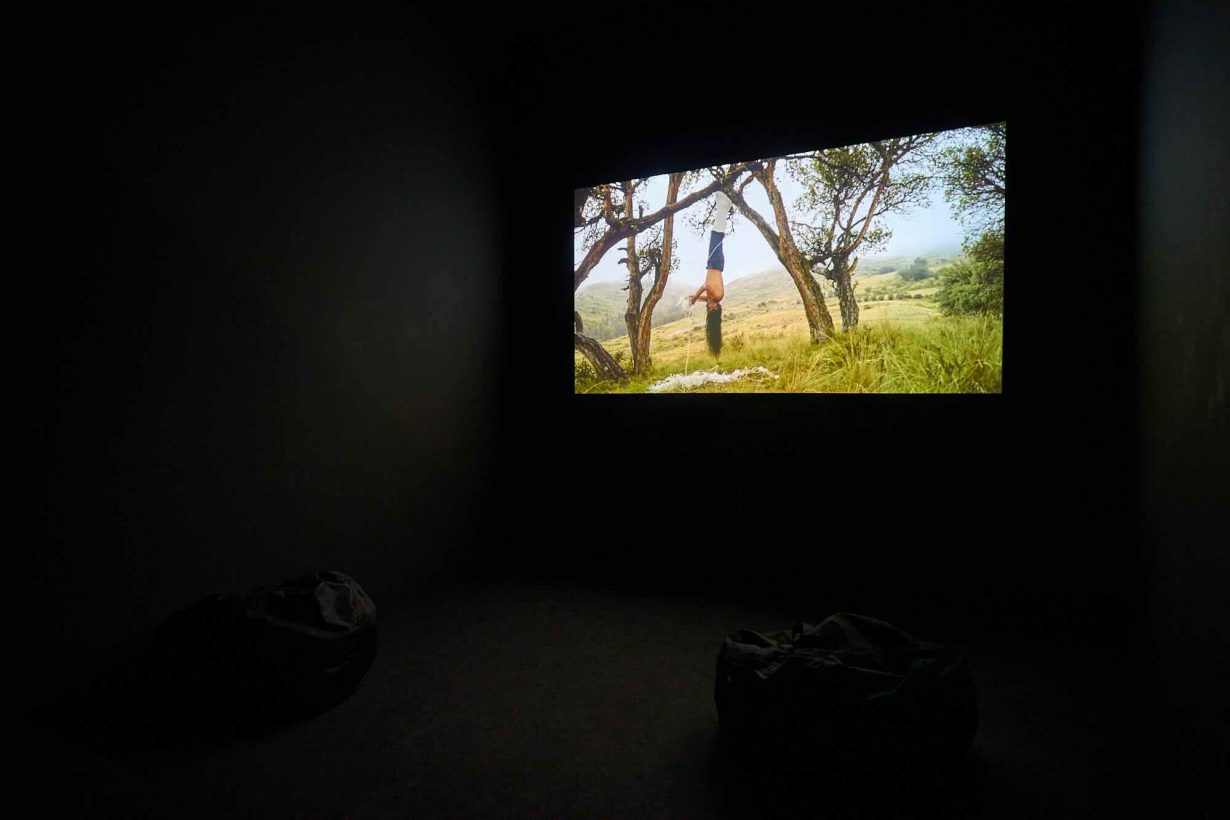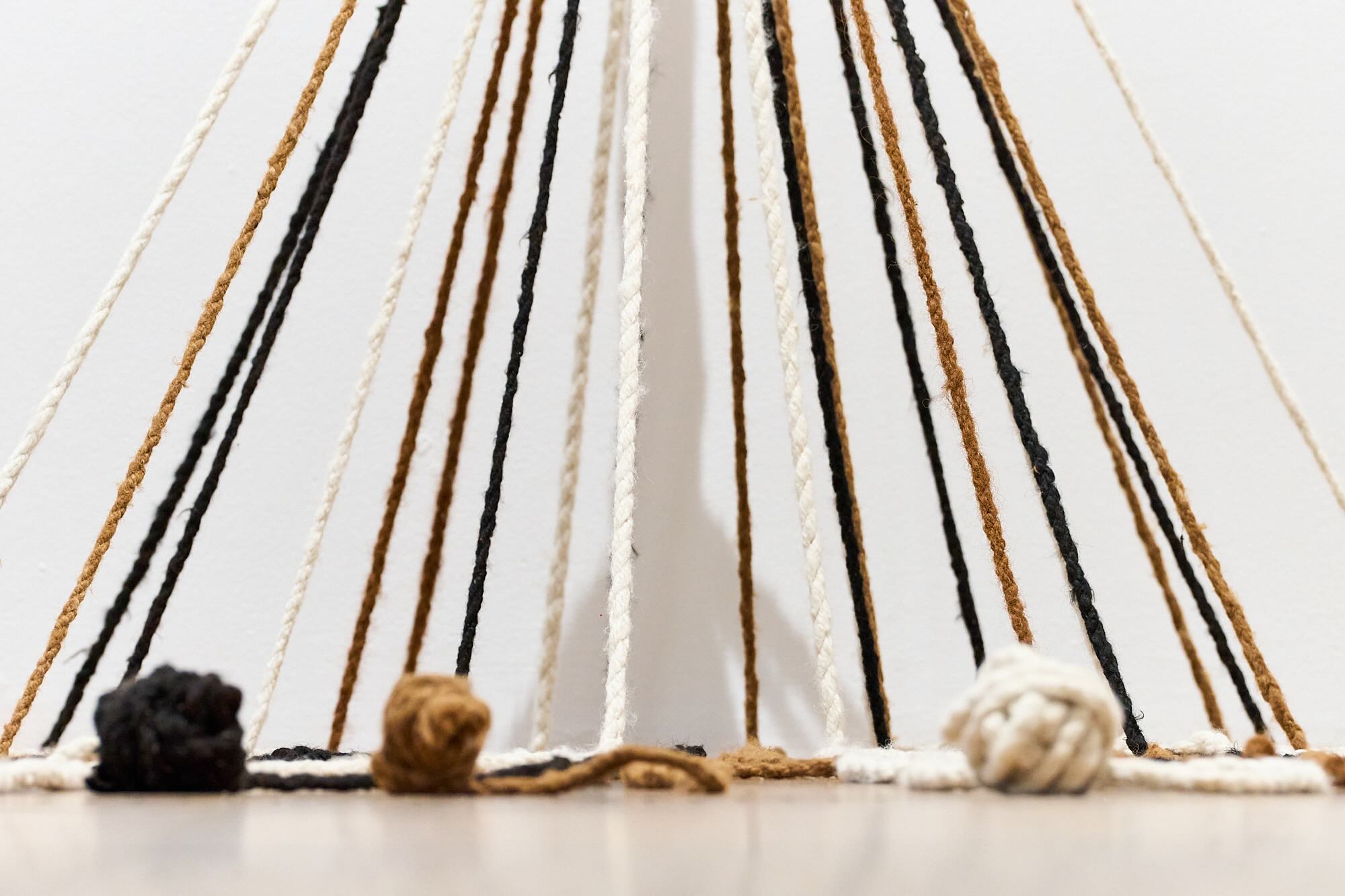To mark the opening of the eleventh edition of the UK’s leading biennial and international contemporary art prize, ArtReview partners with Artes Mundi and catches up with the six international artists presenting their work across Wales from 24 October 2025 to 1 March 2026.
Anchored by a group exhibition at National Museum Cardiff that foregrounds ambitious new commissions and major loans, Artes Mundi 11 invites thematic resonances between practices shaped by displacement, memory and the environmental and emotional costs of political conflict, expanded through solo presentations at venues including Aberystwyth Arts Centre, Chapter in Cardiff, Glynn Vivian Art Gallery in Swansea and Mostyn in Llandudno. Platforming global perspectives on the human condition, Artes Mundi 11 continues the organisation’s commitment to socially engaged art. Among this year’s artists is Antonio Paucar, whose performances, sculptures and video works draw on Andean ritual, Indigenous cosmologies and embodied interventions to consider the frictions between ancestral knowledge and contemporary political realities – from the assassination of community leaders to ecological precarity and the expanding reach of surveillance technologies.

Paucar’s work has been exhibited internationally and is held in major public collections including MoMA in New York, the Institut für Auslandsbeziehungen in Berlin, the Museum of Contemporary Art São Paulo, the Montreal Museum of Fine Arts, the Museo de Arte de Lima and Wrocław Contemporary Museum.
AR How do you help audiences connect with stories that come from your own background or community?
AP At the National Museum Cardiff, I created a work by meditatively weaving with both hands a spiral made from black and white alpaca fibre. The alpaca is a native camelid that has adapted and become integrated into the rugged geography of my country. With this work, Energía espiral del Ayni (2025), I invite the public to connect with an ancient Andean concept contained in the word ‘Ayni’ (in Quechua, it means to cooperate with reciprocity). But Ayni is not only based on the idea that all beings are connected and that reciprocity is the foundation of harmony – it is also a guiding principle that has allowed Andean peoples to endure through time, living in balance and respect with nature.
Another piece that connects with Andean history is the sculpture Illapa (2021), made using three colours – brown, white, and black – and also woven with alpaca fibre. The fibre is braided into a geometric cord that descends vertically from above, moving from the sacred space of the Hanan Pacha (the world above) to the Kay Pacha (the earthly world). The word ‘Illapa’ means lightning in Quechua, a native language of my country, and speaking this language is also a symbol of resistance. Illapa is the name of the deity with three presences: lightning, thunder and rain. The invocation of Illapa to produce rain in Andean communities is essential, as its presence regulates the agricultural cycle, and its absence causes concern. Reflecting on Illapa is vital today, at a time when prolonged droughts are symptoms of the dramatic effects of climate change. My version of Illapa expresses another kind of aesthetic – the complex, millennia-old ancestral Andean technique of braiding, and the rotational symmetry of geometric forms woven with threads of union and resilience.
In the works Illapa (2021), Suspendido en la Queñua (2014) and Energía espiral del Ayni (2005), I use alpaca fibre in different ways and narratives that reference my deep connection with the Andean culture of which I am both heir and promoter, translating its sensitivities into a contemporary language.
These works use, both symbolically and materially, the substance of my culture as a form of dialogue, where ritual functions have not disappeared but remain alive – continuing to weave social structures in community through artistic forms that have persisted from ancient times to the present day in the Andean world.

AR When you work with shared or inherited stories, how do you decide what to include and what to leave open?
AP I generally prefer to leave interpretations and dialogues open so that the audience can form their own perceptions. Most of my works have a poetic, simple, playful and universal narrative that allows even children to access and find themselves within them – my works embrace and invite inclusion.
However, there are also pieces where I find it appropriate to provide a certain sense of guidance or direction – an accompaniment, I would say – as I did in Círculo del Altiplano (2009) and in the video performance El Corazón de las Montañas (2018), in which I incorporated poems that accompany and reinforce the message, since they are connected to the stories of my community as well as to personal experiences and memories.
AR What would you like visitors to experience after spending time with your work?
AP I was born and raised in a traditional Andean rural village, walking barefoot on the earth and connecting with the great spirit of Pachamama, Mother Earth – immersed in ritual practices, stories and Indigenous knowledge passed down by my elders.
My art therefore proposes an Andean way of thinking: an inclusive spiral, collective, connecting reflection and action, past and present in a cyclical way – unlike the linear Western notion of time as unidirectional.
At a time when my country, and many others around the world, are living through violence and grief caused by the presence of death in daily life, my works propose a ritual call for healing and liberation. That is why I invoke that our minds and hearts be illuminated by the flashes of Illapa (2021) or the light of the candle in Altar (2005) in these dark times when violence seems to be gaining ground over life.
And if we feel sensitive or vulnerable, we must draw with our own hands, feet and spirit a ritual circle of protection, as in the video performance Fuerza centrífuga (2008).
It is an invitation for a possible future – one where we can feel and imagine an energetic reconnection with nature. Only then can we bring about change within ourselves, and through that inner change contribute to halting the destruction of Pachamama, Mother Earth.

AR Your woven alpaca sculptures and performances draw on Indigenous Andean rituals while responding to new geographies. How has working in North Wales influenced the gestures or materials you’ve brought into your recent performances and textiles?
AP In North Wales, in Llandudno, I recently carried out a new performance titled Pirueta en la tierra de Llandudno (2025). The video camera records my walk through the landscape of Llandudno –barefoot and with my upper body uncovered – first along earthen paths and then over rocks, continuing in this way until I circle a standing stone from Celtic culture.
Finally, it records my entrance into the gallery space. While my feet rested on the soil I collected during my walk, I had this strong impulse, to use my hands and my feet – which were covered in damp earth – to leave traces on the gallery wall.
Walking barefoot is another way of feeling and connecting with the place; walking with my upper body uncovered is another way of sensing the different winds of this land. Walking respectfully around a standing stone is to connect with the memory and ancestral energy of the place.

Leaving my footprints with the earth of Llandudno is another way of creating a poetic, ritual act – ancestral and at the same time profoundly contemporary. The video is accompanied by music that I composed and performed myself on the Mama Quena flute. The solitude of the landscape is interrupted by the sound of the wind – an Andean sound that converses on equal terms with the ancestral distance of Celtic culture.
Two cultures that were once in dialogue with the landscape, with the earth, its sustenance and preservation, meet again. With an economy of means and materials, poetry becomes synthesis – and in that past, we find present answers about coexistence and respect for our world.
For this reason, it is very interesting how this work, Pirueta en la tierra de Llandudno (2025), enters into that dialogue – setting the rhythm and converging with my other video performances and textile sculptural works within the exhibition space.
Antonio Paucar is showing work at Mostyn, Llandudno, and National Museum, Cardiff, through 1 March 2026
